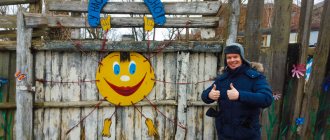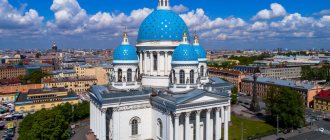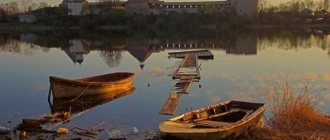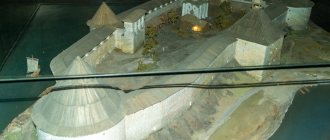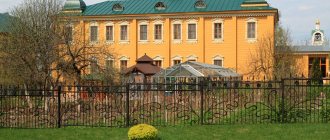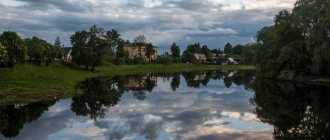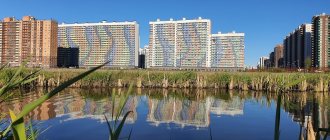no comments, add first
Staraya Russa is the third largest city in the Novgorod region, located on the banks of the Polist and Porusya rivers. This is one of the oldest Russian cities, with a centuries-old, eventful history. The modern appearance of the city is decorated with monuments of ancient architecture: the Spaso-Preobrazhensky Monastery (founded at the end of the 12th century); Church of Mina (XIV century); St. Nicholas Church (XIV-XIX centuries); Trinity Church and Resurrection Cathedral (late 17th century) and others. The rivers flowing through the city diversify the landscape. The cozy streets of the city are surrounded by greenery of gardens and parks.
Water tower on Revolution Square.
Like most ancient Russian cities, Staraya Russa does not have an exact date or even a year of foundation. The first mention of the city in the chronicle dates back to 1167, but it is safe to say that the city was founded much earlier. For example, at the Trinity excavation site in Veliky Novgorod, a birch bark letter was found, dated to the second third of the 11th century. (1030-1060). This letter mentioned two debtors from “Rousa” (Staraya Russa). Archaeological excavations carried out in Staraya Russa itself suggest that the city existed on this site in 1020-1030, and the depth of the cultural layer confirms the earlier residence of people on the site of the ancient city until the 8th century.
The most likely version of the origin of the name Staraya Russa is considered to be hydronymic, from the name of the Porusya River, which was previously called simply Rusa. The name of the river itself is ancient Baltic, coming from the root rud-s- / roud-s-, that is, “red”. There is also a more legendary version of the origin of the city’s name. The Tale of Sloven and Rus says that a hero named Rus settled in this place.
Confluence of the Polist and Porusya rivers, Resurrection Cathedral.
The history of Staraya Russa is inextricably linked with the history of Veliky Novgorod and the Novgorod Republic. Since the end of the 12th century, chronicles regularly report on the construction of churches and monasteries, defensive structures in the city, raids, devastating fires, and wars. In 1478, under Ivan III the Great, Staraya Russa, like the entire Novgorod Republic, became part of the Moscow Principality. Interesting results from the city’s population census at the end of the 15th century have survived to this day. The city at that time was divided into four ends: Rogov, Seredka, Pesiy and Minin. In total, the city had 1,133 households and 3,763 residents. For comparison, in Novgorod at the end of the 15th century there were 50-60 thousand inhabitants (the largest Russian city of that time).
Salt production was the basis for the emergence, development and growth of the city. During a visit to the city in 1693, Peter I ordered to find ways to develop old Russian salt production. Under Catherine II, a new state-owned Salt Works was built on the basis of the old mines, which operated until the mid-19th century.
In addition to the actual salt extraction, local mineral springs were also known for their healing properties. The first scientific studies of waters were carried out in 1815 by Dr. F.P. Haaz, which proved their undoubted medicinal properties. In 1828, physician G. Rauch conducted his research on mineral waters and also obtained data on their medicinal properties. His report was approved, and a decision was made to create a therapeutic balneological and mud resort in Staraya Russa.
The high efficiency of treatment at the resort, proximity to St. Petersburg, accessibility of travel to a wide range of citizens, and the actual fashion for “water” in the upper strata of society made the Starorussky resort, and with it the city, a popular vacation spot for the capital’s elite. In the second half of the 19th century, more than a thousand patients were treated at the resort. Among them is the writer and critic N.A. Dobrolyubov, poet K.M. Fofanov, composer E.F. Napravnik, artist B.M. Kustodiev, Grand Dukes Vladimir and Alexey Alexandrovich. In 1866, on the territory of the Starorussky resort, designed by architect N.L. Benois built a summer theater. One of the best provincial troupes gave performances there, the great actress Vera Komissarzhevskaya began her career here, K.S. came several times. Stanislavsky, visited the theater and Maxim Gorky.
Resurrection Cathedral in Staraya Russa
From 1872 to 1880 The great Russian writer Fyodor Mikhailovich Dostoevsky lived in Staraya Russa. During the years of the writer’s stay in the city, the novel “Teenager”, chapters of the novels “The Brothers Karamazov”, “Demons”, pages of the “Diary of a Writer” and other works were written. The writer's house, which previously belonged to retired colonel A.K. Gribbe, has survived to this day. Every year, international literary readings are held in the house-museum.
In 1878, a railway connection was opened along the route Novgorod - Staraya Russa, connecting the resort with St. Petersburg and Moscow. Initially, the railway from Chudovo station to Staraya Russa was narrow gauge. Passengers from the capital had to change trains at Chudovo. There were 2 trains running along the route every day. Later, in addition to passenger traffic, freight traffic was also opened on the Chudovo-Staraya Russa branch. In 1916, first the Chudovo-Novgorod section, and then the Novgorod-Shimsk section were reconstructed to use the 1524 mm wide gauge. The last section of the railway from Shimsk to Staraya Russa was reconstructed to standard gauge after the Revolution in 1923. During the Great Patriotic War, the railway was seriously damaged, but a decision was made not to restore it. The remaining intact rails were sent to restore the country's most important railway arteries.
During the Great Patriotic War from August 9, 1941 to February 18, 1944, Staraya Russa was occupied by fascist troops. There were fierce battles in the city. By the time of liberation, not a single resident remained in the destroyed city. On April 6, 2015, Staraya Russa was awarded the honorary title of City of Military Glory.
At the request of the administration of the Staraya Russa municipal district and the city of Staraya Russa, a decision was made to the administration of the Novgorod region and the Ministry of Culture of the Russian Federation to celebrate the 1000th anniversary of the history of Staraya Russa in 2015.
How to get to Staraya Russa
Motorists from Moscow will have to travel 530 kilometers along M-11 to Staraya Russa. You can plan a visit to the city on the way to Veliky Novgorod and Valdai.
From Moscow you can also come here by train in the direction of Pskov from Leningradsky Station in about 9 hours. From St. Petersburg there are regular buses from the bus station and minibuses from the Moskovskaya metro station.
- Train timetable Moscow – Staraya Russa
- Bus schedule St. Petersburg – Staraya Russa
It’s easier to get from St. Petersburg - 317 kilometers and about 4 hours by car through Veliky Novgorod and then around Ilmen.
You can get from Veliky Novgorod to Staraya Russa by bus in 1.5 hours.
Base
The life of the townspeople in the 11th-12th centuries is known only from archaeological finds; at that time the city had wooden pavements that were constantly being repaired; people were engaged in trade, crafts and salt making. Then Rusa was part of the Novgorod Republic. In 1192, the Spaso-Preobrazhensky Monastery was opened, which was rebuilt more than once, but has survived to this day.
In 1471, the city was captured and burned by Moscow troops, and 7 years later it was annexed to the Moscow Principality after the campaigns of Ivan III. In 1611 it was captured by the Swedes, along with all the Novgorod lands. In 1617, when the settlement was returned under the Stolbov Peace Treaty, the population of Staraya Russa was 38 inhabitants. In 1763, there was a fire that destroyed the wooden buildings, after which the city began to be built according to plan.
Where to stay in Staraya Russa
For those who want to take a break from stress and heal with local waters, the best accommodation option is the Staraya Russa sanatorium of the AMAKS network with an aquatic center. But having settled in other hotels in the city, you can also visit the aquatic center and drinking pump room, so tourists have a choice - for example, the modern Visavi Hotel located opposite the gates of the resort park or the Polist Hotel on Engels Street with a beautiful view of the park.
And in the vicinity of the city there are many recreation centers intended for lovers of fishing and countryside recreation: “Brown Bear” in the village of Khmelevo, “Retlyo” in the village of the same name, near the beach on the shore of Lake Ilmen.
Resurrection Cathedral
The Resurrection Cathedral can easily be considered the hallmark of the city. It is located in the very center, so it is difficult to miss. You drive along the main street, cross a wooden bridge and here on the bank of the river rises a beautiful, bright and all green building. Looks very impressive! Meanwhile, it is already more than 300 years old. Many thanks to the rector of the cathedral and everyone who serves there!
I still don’t understand what is written here
What to see in Staraya Russa
Staraya Russa is the third largest city in the Novgorod region, located almost 100 kilometers from Novgorod, on the opposite side of Lake Ilmen. This city is indeed old - it has been mentioned in chronicles since the 12th century, but a settlement existed here much earlier. Legends even attribute the founding of the city to Prince Rus, who supposedly lived a couple of thousand years BC. However, a more plausible version is that the city got its name from the Porusya River. By the way, Russa began to be called “old” in the 16th century, when new settlements with a similar name began to appear nearby.
The city with an ancient history was severely destroyed during the Second World War - traces of this destruction are still visible today, and the Museum of the North-Western Front is dedicated to the military past.
On salt waters
Salt has long been evaporated in Staraya Russa, and, as often happens with salt deposits, it gradually became clear that the city has excellent recreational opportunities. For several centuries Staraya Russa has been known as a healing resort with mineral springs. Within the city there are several salt lakes, around which there is a Resort Park with a sanatorium. For treatment, not only water is used here, but also mud from the bottom of lakes, and the very air of the park, saturated with minerals, has a beneficial effect on the body. And opposite the park there is a reconstructed estate of a medieval Rushan salt maker, where you can see how salt was mined in the old days.
Fishing in Staraya Russa
The surrounding area of the city is also famous for its fresh waters, or rather, for fishing in them - in Lake Ilmen and rivers, even those that flow through the city center, fish is found in abundance. So, fishing lovers are offered special fishing tours, including winter ones.
But Staraya Russa is famous not only for its water and salt - the influence of this city on Russian literature is no less important than its role in the development of domestic balneology. After all, Fyodor Mikhailovich Dostoevsky spent the summer months in Staraya Russa for several years with his wife and children. The writer liked the quiet provincial atmosphere of the resort town. Here he worked a lot and created one of his most famous novels, The Brothers Karamazov, many of whose characters were based on the Rushans. Now a memorial museum for Dostoevsky has been created in the house, a monument to the writer has been erected nearby, memorial plaques hang on the houses where the townspeople who “got into the novel” lived, and the City Tourism Center conducts excursions to Dostoevsky’s places.
Old Russian Mother of God
One of the most famous churches in the city, St. George’s Church, which the writer and his household loved to visit, is also associated with the name of Dostoevsky. However, the temple is known not only for its famous parishioners - it houses a miraculous copy of the amazing icon “Theotokos of Old Russia,” one of the largest in the world. The original disappeared during the occupation, but the 19th century copy is also revered by believers.
There are many temples preserved in the city.
Some of them have still not been returned to the Church - such is the fate of the churches of the Spaso-Preobrazhensky Monastery, which houses the Museum of Local Lore. Others - the Church of the Holy Trinity, St. Nicholas Church, the Cathedral of the Resurrection of Christ - became operational again. And in the outskirts of the city, old monasteries are being revived, for example, the Nikolo-Kosinsky Monastery of the 13th century, where pilgrims are shown not only temples, but also an amazing bird yard - a real mini-zoo with peacocks and black swans, which are cared for by nuns.
Museum of the North-Western Front in Staraya Russa
An unusual museum dedicated to the events of the Great Patriotic War on the North-Western Front has been operating in Staraya Russa for more than 40 years.
The exhibition impresses him, first of all, with its desire to show the war from all sides and in all its manifestations, through the eyes of Soviet and German soldiers and residents of the occupied city, through the destinies of people. There are weapons here, the interiors of dugouts and safe houses have been recreated, letters from the front, soldiers’ belongings, and photographs have been collected. Among the exhibits, a church bell from the 16th century occupies a special place: cast in Lübeck, it was brought to Russa by Peter I, and during the war it was taken to Germany - back to Lübeck, whose residents returned it to the Rushan people in 2001.
Resort Park of Staraya Russa
Staraya Russa is one of the oldest resorts in the country. It is known that salt making has been practiced here since ancient times, and various diseases were successfully treated with solutions of local salt. In 1829, a hospital based on local mineral waters was founded. These waters - bromine, chloride-calcium-sodium - are used internally and in the form of baths to treat a number of diseases of the stomach, nasopharynx, respiratory system, and skin.
The resort has two drinking springs and nine springs that feed several salt lakes. At the bottom of these reservoirs (by the way, they do not freeze in winter, so the resort is year-round) sulfide-silt mud forms, another local medical remedy. And around the salt lakes there is a Resort Park, which houses the Staraya Russa sanatorium and a drinking gallery. By the way, in the gallery there is a point of the Tourist Information Center. You can bring your own dishes to the gallery or purchase a disposable glass for water on site.
However, the most famous object in the park is the Muravyovsky fountain. It appeared in the middle of the 19th century: a new well for water was drilled in the park, and a high spring flowed from it, which was named in honor of Count Muravyov, who was in charge of the resort. The power of the fountain is such that the jet can rise 1.5 meters in height, but on ordinary days it looks more modest so that the salt water does not harm the trees growing around. But on the opening day of the resort season at the end of May, the fountain is turned on at full capacity. In the evenings it is illuminated.
Thanks to the evaporation of mineral water from the fountain and from the surface of the lakes, a special microclimate is formed in the park: the air is saturated with useful elements that stimulate the functioning of the heart and lungs. So walks in the park and relaxing on the beach near the Middle Lake are also a method of treatment. The park has walking routes and outdoor exercise equipment.
Estate of a medieval Rushan in Staraya Russa
Opposite the main gate of the Staraya Russa resort there is a reconstructed estate of a resident of medieval Russa - a museum and tourist center that can be visited by everyone.
The complex is being created on the basis of archaeological research data and is not yet completed - new facilities are being built on the territory. But you can already visit a residential hut, a bathhouse, a barn with a chicken coop and a saltworks. The saltworks, by the way, works for real, so here you can buy old Russian salt for cooking and relaxing baths. At the same time, bath brooms, fireweed tea and other souvenirs are sold.
House-Museum of F.M. Dostoevsky in Staraya Russa
A modest wooden two-story house on the banks of the Porusya River served as a summer cottage for Fyodor Mikhailovich Dostoevsky and his family for eight years. According to the recollections of the writer’s wife, this was the place where he worked and lived especially calmly. “The Demons,” “The Teenager,” “Pushkin’s Speech” and “The Brothers Karamazov” were created here, and for the last book Dostoevsky used impressions of Staraya Russa and its inhabitants.
The first museum in this house was created by Dostoevsky’s wife after his death. During Soviet times, the building was nationalized, and the museum reopened only in 1969. Of course, by this time there were no longer any original items left, but based on memoirs and photographs, the furnishings of the rooms of the Dostoevsky family were recreated here, including the writer’s office, living room, dining room, and nursery. Independent tourists at the entrance can take a folder with descriptions of the rooms, but much more information will be provided by an excursion, which can be ordered individually or by joining a group. Here you can also book an interactive excursion dedicated to the writer’s life in Staraya Russa, his family and friends.
A small but very cozy museum appeals to everyone who loves Russian culture, and helps to take a fresh look at Dostoevsky’s work, because the spirit of the pre-revolutionary province, which comes to life on the pages of his books, has been remarkably preserved here.
Church of St. George the Victorious in Staraya Russa
A small, squat church in the city center, near the Malashka River, was built in 1410 and essentially consists of two churches - Annunciation and St. George. Now these are the aisles of one temple. The architecture of the building is simple - a quadrangular base, one chapter, which seems too large for a small church building. But its history is rich and interesting: in the 19th century, the family of Fyodor Mikhailovich Dostoevsky went to this church; in the 20th century, the church for some time remained the only one operating in the city, and thanks to this, it contains many icons and relics from other churches.
But the main thing for which pilgrims visit the Gergiev Church is the list of the famous miraculous icon “Theotokos of Old Russia”. According to legend, the image came to the city from Greece at the end of the 10th century and became famous for many miracles. Later, the icon was transferred to Tikhvin to fight the plague epidemic and could not be returned for a long time - until the end of the 19th century. Then the icon was in the Spaso-Preobrazhensky Monastery, now turned into a museum, and disappeared during the fascist occupation. But because of the “Tikhvin captivity,” the Rushans made a list of icons that has survived to this day. It is located in the St. George Church and is also known for its miracles and healings. It is easy to recognize “Our Lady of Old Russia” even for those who do not understand iconography - this is one of the largest outdoor icons in the world, its height is almost 3 meters and its width is about 2 meters. The grandiose image in a small, quiet temple is mesmerizing, as is the very atmosphere in the temple, which is best conveyed by the epithet “prayed.”
In summer there are a lot of flowers in front of the temple and it is nice to relax on a bench. For an introductory visit, it is good to choose a time when there are no large tour groups nearby and there are no services in the church, in order to admire the icons in silence and without crowds. You can learn more about the church and the icon during the excursion “Orthodox Russia” from the City Tourism Center, which is held on Saturdays.
Old Russian Museum of Local Lore (Spaso-Preobrazhensky Monastery)
The Starorussky branch of the Novgorod Museum-Reserve occupies the premises of the ancient Spaso-Preobrazhensky Monastery, founded at the end of the 12th century and closed during Soviet times. The amazing Cathedral of the Transfiguration of the Lord with fragments of pre-Mongol frescoes has become the location of an archaeological exhibition, in the Church of the Nativity there is an exhibition about the history of literature and theater in Staraya Russa, and in the Church of the Presentation there is an art gallery of local artists, including the famous painter Vasily Semenovich Svarog.
Cathedral of the Resurrection of Christ in Staraya Russa
The temple, located at the confluence of the Polist and Porusya rivers, is the cathedral of Staraya Russa and its main architectural dominant. In ancient times, it was in this place that there was a small fortified settlement - a fort with a small temple. At the end of the 17th century, on the site of a dilapidated ancient church, a stone Church of the Resurrection was built, which was rebuilt already in the 19th century according to the design of the famous architect Vasily Stasov. It is interesting that as many as five emperors managed to visit this provincial temple, or rather, four emperors (Peter I, Alexander I, Nicholas I and Nicholas II) and one empress, Catherine II.
In Soviet times, this picturesque building turned into the Museum of Local Lore, then into the Museum of the North-Western Front, but in the 90s of the last century, a new building was found for the museum, and the cathedral was returned to the Church. Now it has been restored, and on the high bell tower nine bells delight with the powerful and beautiful ringing. By the way, you can climb the bell tower if you arrive in Staraya Russa on Saturday and go on a bus tour of the city’s existing churches from the City Tourism Center. On other days, you can only visit inside the temple, although keep in mind that the interior decoration is quite modest.
Modern times
According to the first Soviet data of 1926, 21,511 people lived in the city. During the years of industrialization, industry began to develop, new enterprises were opened, including aircraft repair shops, now “123 Aircraft Repair Plant”. In the pre-war years, in 1939, the population of Staraya Russa was 37,258 people.
During the Great Patriotic War, the city was under German occupation for a long time (almost three years). Fierce battles took place here; in 2015, Staraya Russa received the honorary title - City of Military Glory. The city recovered slowly, only in the mid-70s the pre-war number of residents was exceeded. Since 1996, the number of residents has been constantly decreasing, due to the low supply of new jobs. In 2021, the city had a population of 29,019.
Etymology[edit]
The origin of the name Staraya Russa is unclear. The most complex and widespread hypothesis was presented by philologists and linguists R.A. Akheyeva, V.L. Vasiliev and M.V. Gorbanevsky. According to this hypothesis, Russa
comes from the Rus - a Slavic people who settled nearby to control the trade routes leading from Novgorod to Polotsk and Kiev - which in turn is generally considered to be derived from the Old Norse term for "men who row" (
fishing rods
), as rowing was the main method of navigating the rivers of Eastern Europe, and this may have been associated with the Swedish coastal region of Roslagen (rowing crews) or
Roden
, as it was known in earlier times.
[13] [14]
means "Old" in
